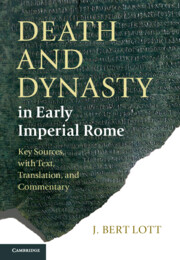1 - Introduction
Published online by Cambridge University Press: 05 November 2012
Summary
This commentary treats a set of texts dating from the first decades of the first century of the Common Era (CE) that commemorated the deaths of four young men: Lucius Caesar, Gaius Caesar, Germanicus Caesar, and Drusus Caesar. The first two, Gaius and Lucius, were the (adopted) sons of the first Roman emperor, Augustus. The second two, Germanicus and Drusus, were the adopted and natural sons respectively of the second emperor, Tiberius. Before their deaths, all four had been the designated successors to the nascent position of princeps or emperor, held by their fathers. None lived to take up the status: Lucius died in 2 CE on route to Spain; Gaius died two years later in Syria. When Augustus died in 14 CE he was, therefore, succeeded by his stepson, Tiberius, whom he had also adopted in 4 CE after the death of Gaius. Tiberius came to the throne with two sons of his own who shared Gaius’ and Lucius’ unlucky fate: Germanicus died in Syria in 19 CE; Drusus at Rome in 23 CE. The deaths of all four were widely and publicly commemorated through ritual, monument, and public business. In particular the Roman senate took the unprecedented step of producing official guidelines explaining just how the princes (an anachronistic but useful word) had been, and were to be, memorialized. Our texts comprise, in the case of Germanicus and Drusus, these senatorial guidelines and, in the case of Gaius and Lucius, the reactions of one provincial community, Pisa, to the guidelines. In addition, one document, the SCPP, reflects the complicated circumstances surrounding Germanicus’ death and the reaction to it at Rome: In it a blue-blooded aristocrat, Cn. Calpurnius Piso, is convicted of treason and conspiracy against Germanicus.
This commentary is designed primarily for use by advanced undergraduate and graduate students. It has three primary goals: First, it aims to expand students’ knowledge of an important period of Roman history through the close examination of surviving primary documents. In particular, our texts reveal much about the process by which the Roman empire came to be and about the social and political consequences of the successful imposition of totalitarian, dynastic rule over the Roman world by Caesar Augustus. They inform us about important events, clarify many aspects of early imperial governance, reveal the growing public influence of imperial women, and allow us to gain a more complete historiographical understanding of the received literary histories, especially Tacitus. More importantly, reading them together allows students to see “history in action,” to question the process by which a new form and language of governance developed over time rather than viewing it only in hindsight, from the vantage point of later writers, such as Tacitus, who knew the outcome.
- Type
- Chapter
- Information
- Death and Dynasty in Early Imperial RomeKey Sources, with Text, Translation, and Commentary, pp. 1 - 53Publisher: Cambridge University PressPrint publication year: 2012



